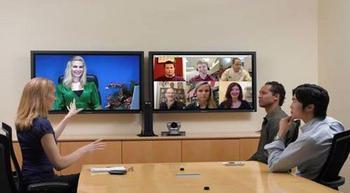 A recent global survey shows that the growth of the video market depends on the use of more users and the full integration with business processes. Factors that promote the increasing popularity of videoconferencing: 94% of respondents believe that increasing users can make video more popular and convenient video access (accounting for 85% of respondents), and video and business platform more fully integrated (accounting for respondents (83%) and video solutions (80%) embedded in IM/UC clients such as Microsoft. The global commercial market for videoconferencing has grown rapidly, and surveillance applications are erupting.
A recent global survey shows that the growth of the video market depends on the use of more users and the full integration with business processes. Factors that promote the increasing popularity of videoconferencing: 94% of respondents believe that increasing users can make video more popular and convenient video access (accounting for 85% of respondents), and video and business platform more fully integrated (accounting for respondents (83%) and video solutions (80%) embedded in IM/UC clients such as Microsoft. The global commercial market for videoconferencing has grown rapidly, and surveillance applications are erupting. Video conferencing business applications are growing rapidly Polycom (Nasdaq: PLCM)'s latest survey of 5,000 end-user video users worldwide shows that the use of videoconferencing, venues and people are changing with each passing day. The conference is becoming a rapidly growing enterprise productivity. The results of the survey were published in a report titled “End-User Survey: The 'Real' Benefits of Video†that aims to fully reflect the business benefits, deployment trends, use cases, adoption rates, and future directions of videoconferencing.
The survey shows that 94% of respondents believe that the greatest advantage of videoconferencing is to increase production efficiency, followed by improving communication efficiency (88%), accelerating the decision-making process (87%) and reducing travel expenses (87%); When asked which of the current specific work would use video conferencing, “customers, partner meetings†became the first choice (71%); a quarter of respondents stated that video conferencing is a daily communication tool that must be used.39 % of respondents were used once a week, 21% used once a month, 14% of respondents were used once every few months; multi-vendor environment is very common, so interoperability is particularly important, 60% is Investigators stated that they "mainly use" videoconferencing equipment or software from more than one vendor; 32% use three or more vendor solutions; video communications can help teleworkers establish closer ties with their colleagues, and 87% at home Respondents at the office strongly agree or agree that "the use of videoconferencing does not alienate their working relationship."
"This comprehensive survey confirms the effectiveness of our efforts over the years. Whether or not you are in the office, as long as employees can achieve face-to-face communication and collaboration through any device, and achieve more with less," said Andy Miller, President and CEO of Polycom. , "In addition to helping create a more efficient and united team, video collaboration can help companies and organizations build effective sales and technical teams, better customer service, and more stable partnerships. The world is moving toward ' The vision for video collaboration is everywhere, and Polycom’s goal is to provide video solutions that are easy to use, secure, affordable, and suitable for the widest range of devices and environments, including panoramic telepresence, conference rooms, desktop systems, and notebooks. Computers, PCs, browsers, tablets, and smart phones will make this vision a reality.â€
In December 2012, Wainhouse Research, with the support of Polycom, investigated 4,737 end users of videoconferencing systems around the world. Of these, 63% came from North America, 27% came from Asia Pacific, 9% came from Europe, the Middle East and Africa, and another 1% came from Latin America. From the scale of the companies interviewed, 20% of them are small companies with between 1 and 49 employees. About 17% are large companies with more than 10,000 employees. Companies of all sizes participate in the survey. In addition, the survey also covers different industries.
Anytime, anywhere video communication: Users can hold video conferences on different devices and in different environments – whether it is through conference rooms, computers, or increasingly popular home offices and mobile devices. Desktop and laptop computers are the most commonly used video conferencing devices (71% of respondents), followed by conference room/group video systems (65%), tablet computers (34%), and smart phones (33%); The conference room is currently the most favored videoconferencing environment. 79% of the respondents use the conference room for video conferences, and 69% video in the office; the "mobile" video conference has the fastest growth rate - the main locations include the airport and the hotel. And the customer site; PC is currently the most important video communication device, but the arrival of the mobile era is an indisputable fact that more than 90% of respondents have a smartphone and 75% have a tablet. More than 77% of respondents use smart phones to work, and respondents using tablet computers reach 50%; respondents expect that the use of mobile devices in video collaboration will continue to grow over the next year.
“A lot of people have misunderstandings about videoconferencing. They think that the only real driving force for videoconferencing is to reduce travel. However, this survey shows that video conferencing plays an important role in improving work efficiency and expanding the scope of discussion.†Wainhouse Research Senior analyst and partner IraM.Weinstein pointed out, "In addition, this survey confirms end-user recognition of Polycom's core values, including ease of use, integration with telepresence and instant messaging (IM), and video support for mobile devices. By focusing on the needs of hotspots, Polycom continues to build video solutions that are easy to purchase, easy to deploy, manage and use."
Videoconferencing HD monitoring applications HD videoconferencing has been transformed from the original SDTV videoconferencing equipment purchase to high-definition videoconferencing system integration for front-end video/audio capture, video/audio display, mid-phase video/audio compression, transmission, and late viewing / Audio editing and recording must be performed around high definition. Any non-HD device is used in any one loop. Even if the image and sound can be displayed without error, the original HD quality will become standard definition quality.
Similarly, for front-end video capture, high-definition cameras can only be the only solution. The standard imaging device for standard-definition cameras is 1/4 CCD, or CMOS. Pixels are between 400,000 and 500,000. For high-definition cameras, the imaging device is typically 3*1/3 CCD or CMOS, and the pixels are between 100 and 2 million. Considering the cabling factor, high-definition cameras and high-definition video conferencing terminals are often connected via the HD-SDI interface. It can reach up to 100 meters.
Similarly, high-definition video conference conferencing can not only receive video images of ordinary high-definition cameras, but should also be able to be compatible with other broadcast-level professional HD cameras, high-definition switcher images. Therefore, how to arrange wiring, wiring distance, and what kind of material wiring is the problem we must consider. Only HD-SDI is our only solution because it allows coaxial cables to carry lossless signals at a distance of 100 meters. And using the BNC head to make the line is very simple, without professional cables and connectors, you can easily buy in any computer market and audio store.
At present, large-scale domestic and foreign broadcast equipment suppliers have related high-definition camera equipment. The standard high-definition interfaces of these devices are based on the HD-SDI interface.
Musk Xylene was once the most widely used of the "nitro-musks", but its use has declined sharply since the mid-1980s due to safety and environmental concerns. Itsexplosiveandcarcinogenichazards are recognized to be borderline, and musk xylene is a useful example of the lowest level of such risks which need to be taken into account.

Musk Xylol Powder,Musk Xylol Powder Juice,Musk Xylol Powder Keg,Musk Xylol Powder Kit
Gan Su Original Flavor Co.,ltd , http://www.futureperfume.com